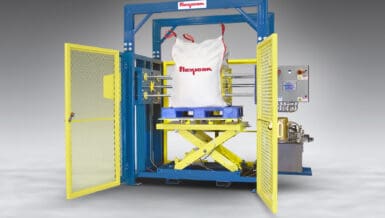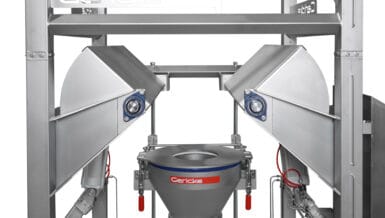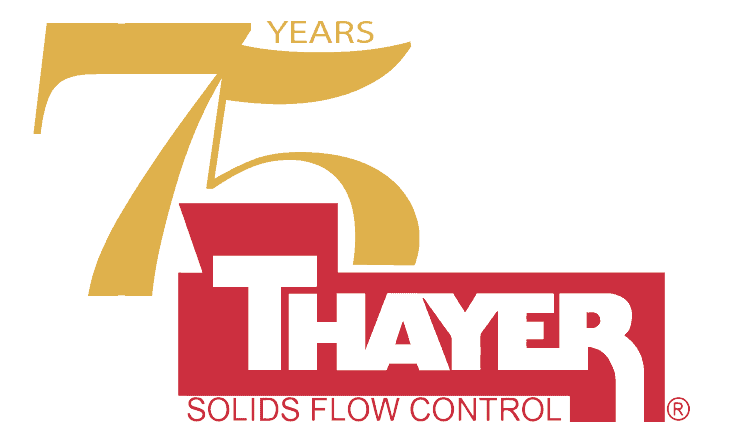Replacing filter bags on demand may seem like a convenient way of managing maintenance costs. But waiting to replace bags at the point of failure, or just before, can lead to a greater risk of non-compliance with emissions standards, higher costs, and higher overall emissions levels. So why are some cement producers opting for partial replacement over full? With cement plants working around the clock to meet market demands, maintaining a well-running emissions filter system can be a tough task. Long-lasting, reliable filter systems and bags that balance cost with productivity, all while staying in line with strict emissions standards, are just some of the considerations
Poorly performing filter bags can often lead to unexpected and costly production shutdowns, as a result of a high pressure drop across the entire filter. This can lead to increased electricity usage and consumption of compressed air. Therefore, robust baghouse maintenance and replacement strategies are crucial elements for long-term cement plant profitability. When it comes to baghouse replacement strategies, there are two main factors that help to determine when bags should be replaced: the level of dust emissions at the filter outlet and the differential pressure (dP) throughout the filter system. Filter bag replacement in general, regardless of whether it is partial or full, leads to improved emission levels and dP. While many cement plant operators opt for partial bag replacement, could this strategy be hurting them in the long term? FLSmidth has undertaken some research and analyses to compare the two strategies.
Frequent bag replacement In one case, a FLSmidth customer was replacing bags on demand – to the point where bags were being replaced bi-weekly. Over a two year period, 1160 bags were replaced. This represents more
than 100% of the filter bags in the system, which was made up of 864 bags. But it was not just high bag consumption that was an issue; averaging 2250 Pa, the high dP was causing a high cleaning frequency. A full bag replacement was called for. Following this, reported issues related to broken bags ceased and the plant experienced no problems with dP: the average measurement sitting at a comfortable 1800 Pa. The filter system has been in operationfor almost two years, with less than 10% wear and tear (W&T) of bags. With this new bag replacement strategy in place, the plant has saved at least 20% OPEX of the filter. This example clearly illustrates the operational and cost ramifications of partial bag replacement. In a general analysis, a full bag replacement strategy can reduce OPEX costs by between 15% and 30% in the long term, compared with a partial bag replacement.
The price of partial replacements
Partial bag replacement carries a higher risk of plant downtime due to unexpected bag failure. It also requires more frequent cleaning, causing an imbalance in flow that leads to filter inefficiencies. Why? Following partial bag replacement, the remaining aged bags possess more resistance to the flow than new ones, giving the flow an easier path through the new bags. This imbalance in the internal flow forces the new bags to have a higher gas flow ratio of between 5% and 10%, depending on the media material. It is therefore clear that mixing new bags with aged bags will reduce bag lifetime, increasing the filter’s operating cost.
Question the status quo
Replacing bags on demand provides a false belief that material and labour costs are comparable with a full replacement or, worse, that it is more economical. Unfortunately, cement plant operators are selecting partial replacement, without having a full understanding of the benefits of a complete bag replacement. FLSmidth Product Sales Manager, John Johnson, explains it in household finance terms: “The perception may be that by replacing bags on demand, the total replacement costs can be paid in instalments. But the reality is that you end up paying higher ‘interest’ in the form of materials and other hidden costs, which can be up to 30% higher compared with the cost of a full replacement. While replacing all bags sounds expensive, the long-term savings are evident. Plus, there are several other operational and compliance benefits.”
Reap the benefits
At first glance, the task of full replacement may seem too difficult or too expensive. However, the actual investment required is often over-estimated and full replacement can be completed within the regular maintenance budget and schedule. A full replacement strategy offers savings in material costs (such as filter bags) and the hidden costs associated with labour, maintenance, electricity usage, compressed air usage, and overall production costs. Adopting the strategy is a means of improving long-term profitability. An extra benefit of full replacement is the ability to perform an exhaustive check of all the critical parts of the filter, including the cleaning system and the casing seals. This can be likened to a new commissioning every time a full bag replacement is completed. Maintenance and repair can be done simultaneously, ultimately reducing maintenance costs further down the line.
Emissions matter
In countries and regions where there are strict particulate matter emission standards, cement producers see the changing of bags as an opportunity to ‘tune’ the filter to achieve the necessary emissions compliance. However, in regions that allow higher emissions limits, the
Performance measures
When researching the effectiveness of different bag replacement strategies and assessing baghouse filter performance, FLSmidth’s R&D team completed calculations based on hard data, gathered over various parameters. These included the following:
- Emission levels.
- Differential pressure (dP).
- Filter media permeability.
- W&T percentage over the filter lifetime
practice of changing bags on demand may be more common. While emissions compliance is of high priority, this maintenance strategy does not consider the hidden costs that come with a poorly-performing baghouse filter system.
Ensure compliance
In an effort to compare emission levels after commissioning following full replacement with those following partial replacement, the R&D team at FLSmidth conducted tests to assess the performance of baghouse filters. From the resulting calculations, the team could plot emission levels in relation to the two bag replacement strategies.
When a partial replacement occurs with, for example, half of the bags being replaced instead of all, emission levels are not so desirable. Generally speaking, emissions are emitted from all filter bags, with some bags contributing more than others, depending on their condition. If only half of the bags are replaced, the remaining half will contribute substantially to the new emission of the filter. This results in significantly higher emissions than in the case of a full bag replacement. The results confirm that greater control over emissions can be achieved with a full replacement.
Nip it in the bud
Close monitoring of bag deterioration acts like a comprehensive health check. Generally speaking, there are three stages of W&T during a bag’s lifetime. However, the deterioration of filter bags is progressive and is never identical for each individual bag.
By knowing the exact state of the filter bags, monitoring plans and maintenance programmes can be formulated to extend bag lifetime. It is easierto manage bag lifetime when there is a detailed overview of the number of broken bags and their corresponding locations. Poor monitoring and inadequate planning in process filters often leads to overestimating the amount of spare parts needed, including filter bags, cages, and cleaning valves. This results in an unnecessary excess cost that increases tangible fixed assets. Solid monitoring and planning helps to inform decisions such as spare parts requirements, so that such excess costs can be avoided.
Improved safety
While monitoring allows investigation into wear causes, it can also help to reduce the environmental health and safety risk. By identifying potential problems early, the number of maintenance interventions is reduced. Maintenance can, therefore, be completed in a more structured and scheduled manner, resulting in lower long-term maintenance costs and improving safety. A detailed maintenance plan supported by competency training is essential for predictive maintenance. Similarly, keeping thorough records of equipment and process operation parameters can help to detect early signs of any costly issues that may arise.
Time is of the essence
While it is not ideal to mix new bags with aged bags, the timing of replacement is also important. The condition of bags nearing the end of their lifetime can be acceptable in terms of characteristics such as permeability and dust penetration. It would not be ideal to replace them while they still have some life left in them. With this in mind, when is the optimal time for full bag replacement? This can be identified when the accumulated percentage of W&T bags since commissioning reaches a pre-defined point. This is usually between 5% and 15%. In some heavy-duty applications, however, this can be extended to 25%. Another common strategy is preventive filter bag monitoring, through laboratory analysis of parameters such as average filter media strength, air permeability, recovery after cleaning, and microscopic examination.
Knock-on effect
A damaged or malfunctioned filter bag is considered a primary failure. If left unattended for a period of time, a primary failure can result in the rapid deterioration of adjacent bags as a result of the reinjection of dust. The detrimental effect on surrounding bags is commonly referred to as secondary failure. Secondary failure may be W&T in venturis and blowing pipes, which lead to inefficiency cleaning, and, ultimately, affect bag lifetime.
A winning strategy
There are significant economic and production benefits for following a clear replacement strategy where all bags are replaced at once. The difference between partial and full bag replacement strategies can be likened to filling the fuel tank on a long trip. Starting a trip with a full tank of fuel can cover the maximum distance. When a refill is needed and the tank is only partially filled, it will not be long before another stop at the gas station is required. It makes sense to fill the tank completely when refilling, in order to save time and costs.
About the authors
Jose Maria Umbert Palazuelos is Fabric Filter Product Manager at FLSmidth Airtech.
Henrik Vittrup Pedersen is General Manager at FLSmidth Airtech.















































